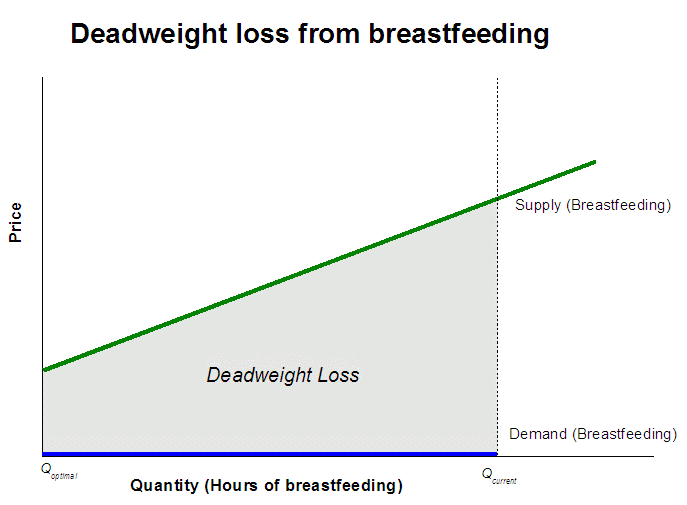I've been thinking about the things we do every day which we all assume are beneficial, but which we probably overdo. People rarely stop to consider the costs and benefits of their behaviour. Even when they think about it they often don't measure it in terms its real value - what the market is willing to pay. Many things we give away for free and overconsume because we misjudge the true costs and benefits.
A good example of this is breastfeeding. How often do you really stop to consider what the right amount of breastfeeding is? What are the costs and benefits of this common human behaviour? It is often assumed that breastfeeding costs society nothing, but is not strictly true. Neglecting to measure opportunity costs is one of the most frequent fallacies of economic reasoning. However, the true costs are fairly easy to measure. They are simply the opportunity cost of the mother's time, or what she would earn if she were to return to the workforce. So we can here see one reason why we may overproduce breast milk. Because breastfeeding infants do not face the true costs of production, they overconsume breast milk. We will examine below the extent of this overconsumption.
The benefits are slightly trickier, but measuring these is also fairly straightforward if you take a moment to consider it. The market for breast milk is overwhelmingly dominated by young children, who have lower than average incomes. So the demand curve for breast milk will look a little different to the demand curves you're used to seeing in economics textbooks. If we reasonably assume that the income for the majority of children demanding breast milk is approximately $0 and that they will spend virtually all their income on breast milk, constructing a demand curve is simple. And from this demand curve we can discover the socially optimal level of breastfeeding.
I've attempted below, to model what the market for breastfeeding might look like. The supply curve is upward sloping, reflecting normal labour market economics. The demand curve actually follows the horizontal axis for it's whole length, reflecting the lower purchasing power of young children. Just as with any market we want to equate costs and benefits which will minimise the deadweight loss. Society currently produces quite a large amount of breast milk (Qcurrent). However, as you can see, at this point the costs of production heavily outweigh the benefits. In an unfettered market, production will move away from this suboptimal level towards a socially efficient equilibrium. Perhaps surprising to some, it turns out that the optimal level is actually much lower (Qoptimal). As you can see, at this level of production the deadweight loss is zero. At a production level of zero, costs and benefits are also equalised at zero - you have a social optimum!
This is just one example of how economics can provide helpful and sometimes surprising solutions to the real world problems we face every day.


You are a very very funny man Ryan.
David / 10:22am / 18 September 2007
Based on the optimal this seems to mean whilst the deadweight loss is theoretically reduced to zero the actual deadweight will in fact equate exactly with the deadweight of the dead kiddie with no money.
Perhaps the current surplus could be allocated to address this market failure by issuing all kiddies with a breast allowance to put in some real competition into the breast feeding market. That of course would also contribute to increase the efficiency of breast feeding in a way that medicine has failed.
Looking at the issue more politically now if the breast allowance was allocated at higher levels in marginal seats you may well set up real competition for good value well produced breast milk for the marginal.
If you were to then think about the issue from a marketing perspective you’d first need to look at the packaging issues.
keith / 10:43am / 18 September 2007
ROFL!
Please let this be included as a chapter in any update of “Freakonomics” or “The Undercover Economist”
BTW – just be careful when looking at the “packaging issues”. If done indiscretely, it can lead to litigation.
Anonymous / 11:13am / 18 September 2007
Dude.
Wil / 6:31am / 19 September 2007
excellent…i assume that breast feeding is both excludable and rivalrous in consumpution so the good is a private good…i won’t doubt that the good is overconsumed, but i will doubt the horizontal demand curve since an infant will experience diminishing marginal utility and also faces choices for his/her time…if the demand curve is downward sloping, i don’t think this changes your analysis…thanks for one of the best blogs i’ve read recently…
Mike Fladlien / 10:08pm / 23 September 2007